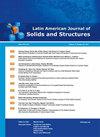可变轴向复合材料壳体强度和应力集中的多目标优化框架:一种元启发式方法
IF 1.1
4区 工程技术
Q3 ENGINEERING, CIVIL
引用次数: 0
摘要
本文章由计算机程序翻译,如有差异,请以英文原文为准。
A Multiobjective Optimization Framework for Strength and Stress Concentration in Variable Axial Composite Shells: A metaheuristic approach
A metaheuristic approach for variable axial composites considering multiobjective optimization is investigated. The proposed methodology is based on the combination of three main parts: a methodology for defining the orientation of the fibers in the laminate, a structural analysis program (based on the Finite Element Method) and an optimization algorithm. It is important to highlight that a radial basis function (RBF), which describes a smooth fiber pattern, is generated using control points. The novelties of the present methodology consist of a proposal for a generalized parameterization technique, which allows the investigation of mechanical strength and stress concentration of variable axial composites. Thus, NSGA-II multiobjective genetic algorithm is used as optimization tool to define the fiber orientations. Besides, ax metaheuristic approach is used in situations when it is desirable to simultaneously minimize the stress concentration factor ( 𝐾𝐾 𝑡𝑡 ) and a failure criterion index ( 𝐹𝐹𝐹𝐹 or Φ ). Two case studies are investigated: a double notched plate and a tube with a transverse hole.
求助全文
通过发布文献求助,成功后即可免费获取论文全文。
去求助
来源期刊
CiteScore
2.80
自引率
8.30%
发文量
37
审稿时长
>12 weeks

 求助内容:
求助内容: 应助结果提醒方式:
应助结果提醒方式:


